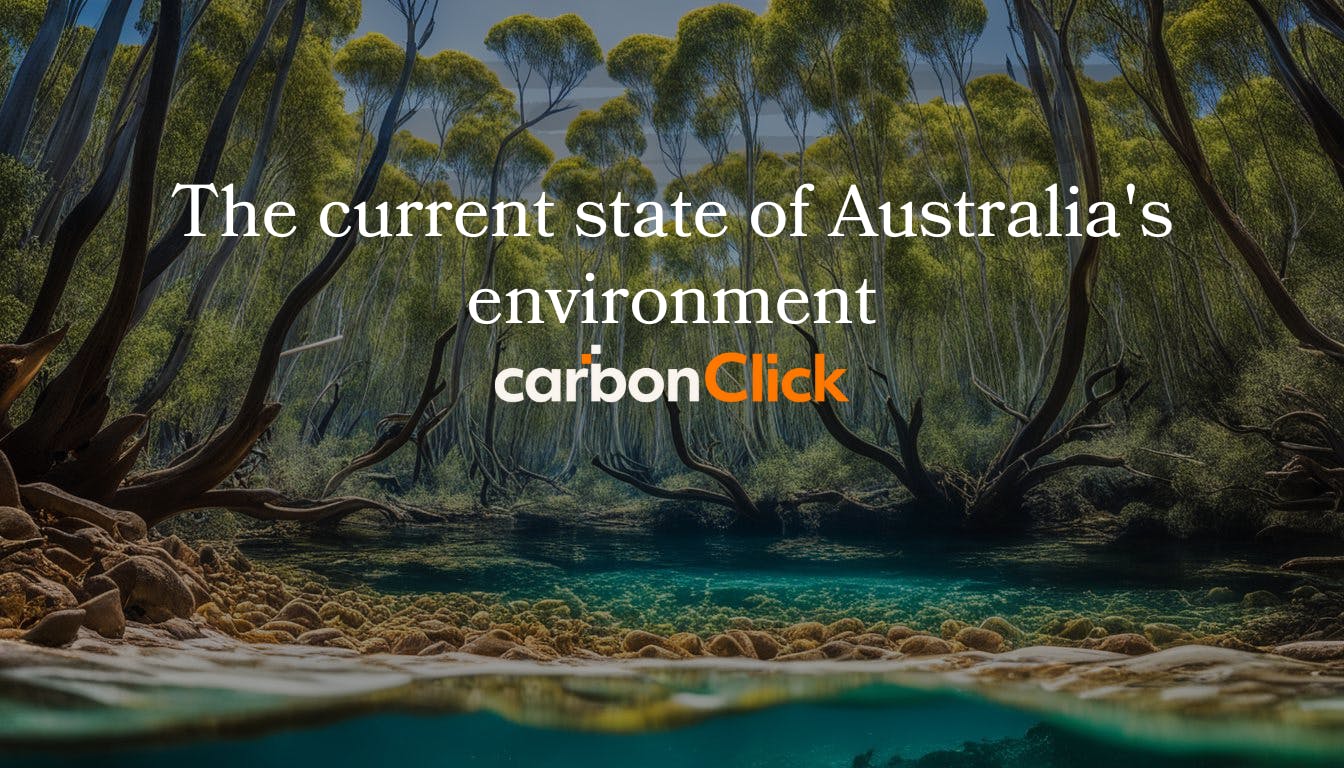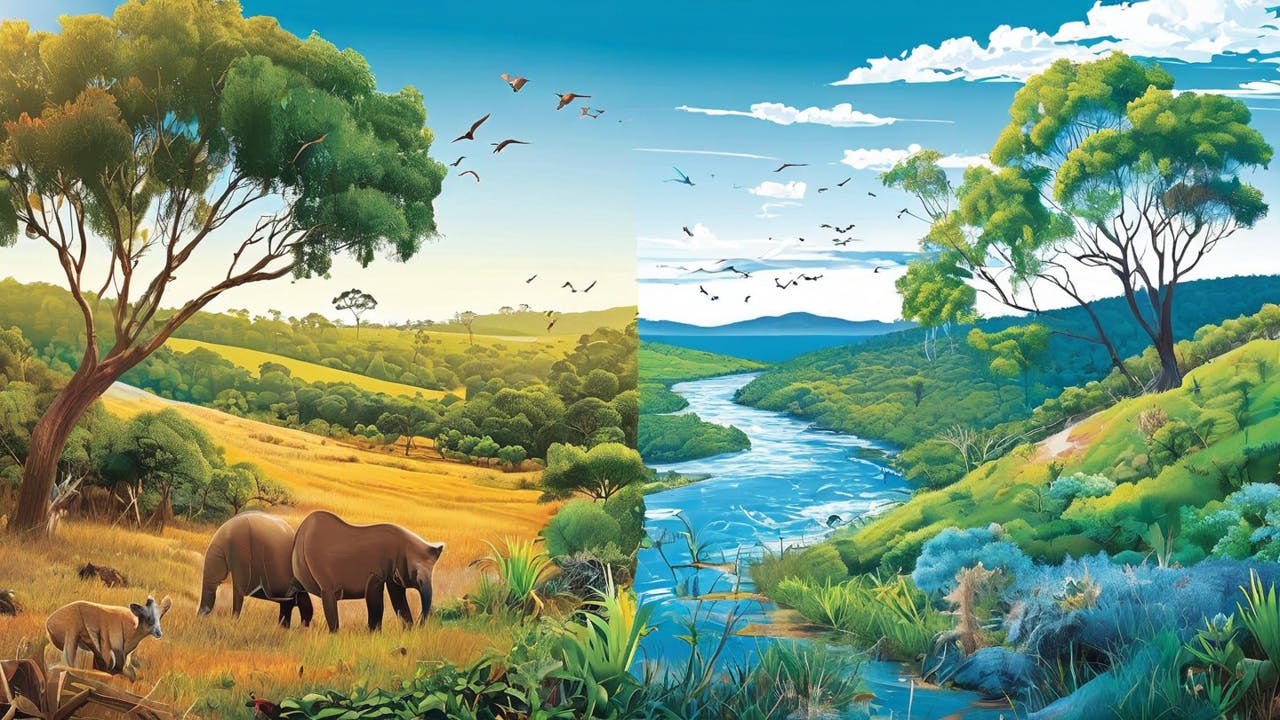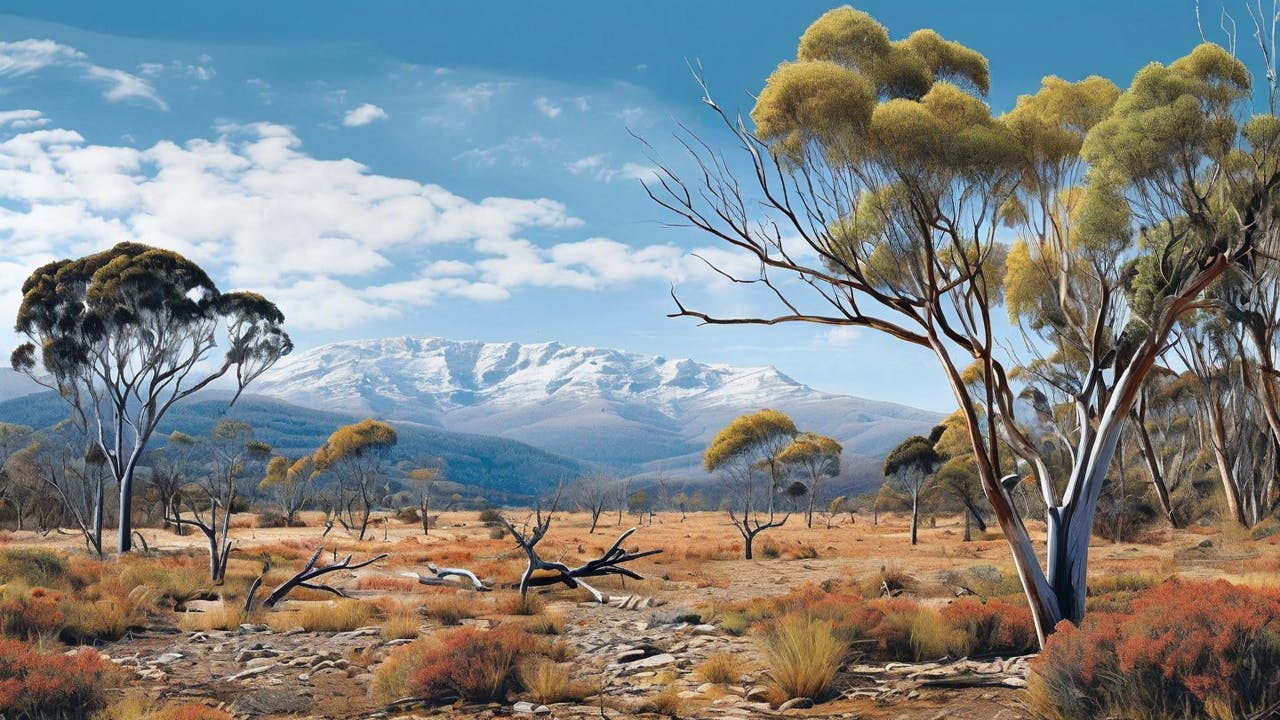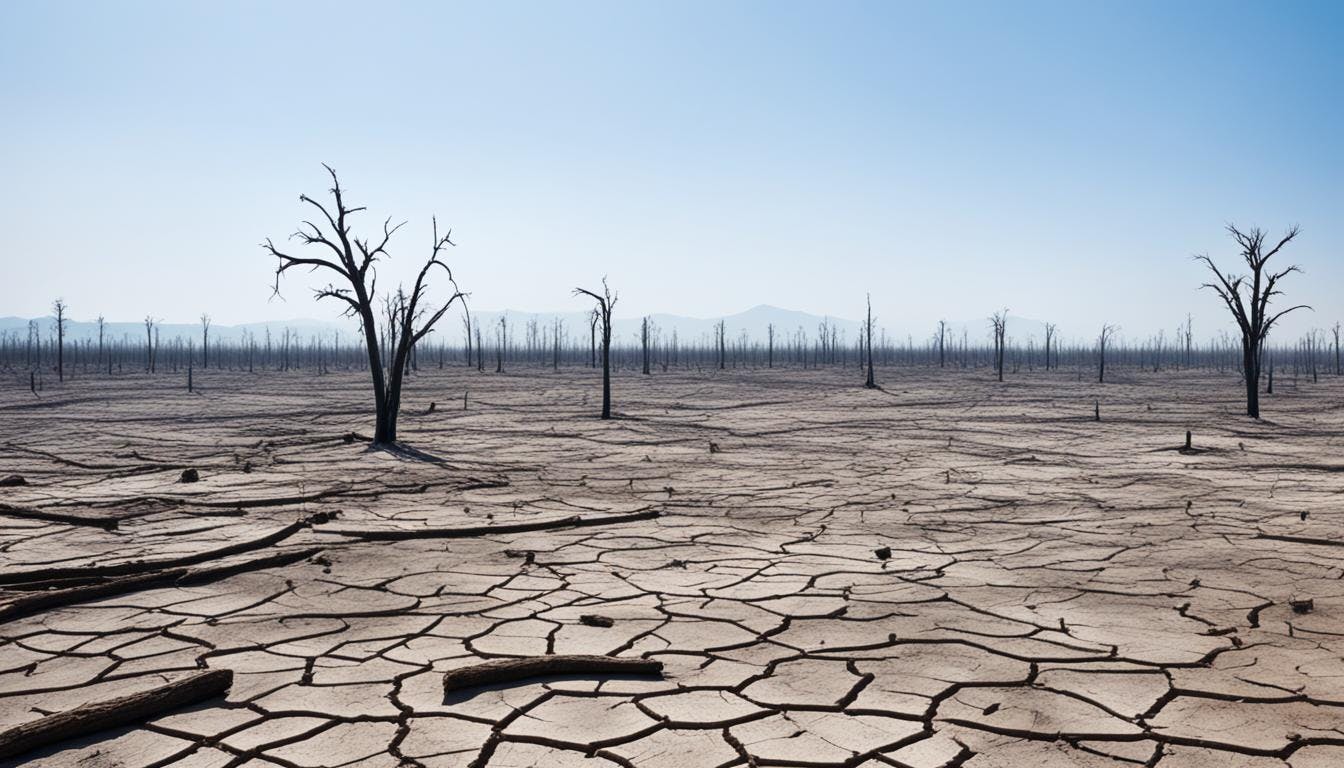Go the extra mile
Towards a cooler planet
The current state of Australia's environment
1 February 2023
Australia faces significant environmental challenges, such as a decline in biodiversity and damage to habitats. Our research indicates that many ecosystems are under considerable stress. This is primarily due to climate change and human activities, such as deforestation and urban development.
The past nine years have been the warmest on record, with 2023 being approximately 1.45ºC warmer than historical averages. This warming trend is increasing the frequency of extreme weather events, which adversely affects both health and the environment. For example, from 2012 to 2022, there was an average of 912 hospitalisations each year due to extreme weather.

The current state of Australia's environment
Australia's oceans and marine life are also suffering from rising global temperatures and increased greenhouse gases. This poses a serious threat to our diverse marine ecosystems.
Australia has experienced a significant loss of mammal species, more than any other OECD country. This decline is partly attributed to habitat destruction. Since 2016, there has been an 8% increase in the number of species at risk. Urgent action is needed, including efforts to protect 30% of our land and oceans by 2030.
Key Takeaways
- Biodiversity decline in Australia is accelerating.
- Habitat destruction remains a critical issue due to urbanisation and deforestation.
- Climate impacts manifest through extreme weather and rising temperatures.
- Conservation strategies are paramount to counter ongoing environmental degradation.
- Indigenous contributions and environmental management play significant roles in combating these issues.

Overview of Australia's environmental health
Australia's environmental health reflects how well our ecosystems can withstand increasing pressures such as climate change, urban growth, and human actions that harm nature. Over the years, many environmental indicators have shown concerning trends.
One such indicator is the decline in native plants and soil quality. This impacts our ability to maintain natural resources like food and clean water. A report has highlighted Australia's growing vulnerability to climate change and its health impacts, emphasising the need for early intervention.
The exceptionally wet November and severe bushfire seasons illustrate the unpredictability of Australian ecosystems. The Australian Bureau of Meteorology states that 2023 was the warmest year in 174 years, with temperatures 1.45ºC above pre-industrial levels. This underscores the urgency of addressing our environmental health.
Urban expansion
Urban expansion is also encroaching on protected areas, increasing pressure on ecosystems. It is essential to implement robust environmental management practices to enhance ecological resilience and safeguard our natural heritage for future generations.
The 2019-2020 bushfire season was particularly devastating, with estimates suggesting that around 3 billion animals were affected. Such events highlight the fragility of our ecosystems and their significant impact on both nature and the economy.
We must heed these environmental indicators, as they reflect Australia's environmental health and guide our actions. Strengthening ecological resilience through effective environmental management and policies is crucial for maintaining sustainable and healthy ecosystems.
Impact of climate change on Australian ecosystems
Australia is experiencing significant changes in its environment due to climate change. Over the past 100 years, global temperatures have risen by 1.1°C, while Australia has warmed by 1.4°C. This relatively small but crucial increase in temperature is leading to substantial changes in Australia's ecosystems.


Increased frequency of extreme weather events
Climate change is resulting in more frequent extreme weather events in Australia. In 2019, it was recorded as the hottest and driest year ever. The frequency of heat records has doubled over the past 50 years. Heatwaves are now more common and deadly, causing more fatalities than any other type of disaster.
The bushfires of late 2019 and early 2020 were unprecedented in severity, causing extensive damage to the environment.
Australian Climate Change Effects Marine life is also at risk. Rising sea temperatures and increased acidification are damaging kelp forests, seagrass beds, and coral reefs. The Great Barrier Reef is experiencing more frequent and severe coral bleaching events.
Effects on Biodiversity
Climate change is making it increasingly difficult for many species to survive in Australia. Terrestrial, freshwater, and marine ecosystems are all under stress. Many eucalypt trees may lose their habitats in the next 60 years.
Alpine regions are experiencing reduced snowfall, a trend that began in the late 1950s. Changes in water quality and quantity are causing fish kills in areas such as the Murray-Darling Basin.
Disturbances in natural systems are becoming more common, including more frequent and intense fires and the spread of invasive species. Without a reduction in greenhouse gas emissions, the situation for Australia's ecosystems is expected to worsen.


Deforestation and land degradation
Deforestation in Australia has reached alarming levels, leading to land degradation and environmental issues. Over the past few decades, a significant portion of Australia’s native forests has been cleared for agriculture, urban development, and mining.
Between 2014 and 2019, nearly 290,000 hectares of primary forest and 343,000 hectares of regrown forest were removed. This deforestation exacerbates soil degradation and negatively affects water quality, creating substantial problems for both the environment and the economy.
Soil Salinity Issues
Removing trees harms soil health. Deforestation impacts include rising soil salinity levels. Salinity makes the land less good for farming.
Poor soil management further exacerbates these issues, leading to decreased farm productivity and reduced incomes for farmers. Indigenous people recognise the connection between healthy forests and soil, emphasising the need for sustainable land use practices.
Economic costs of land degradation
The economic impact of environmental degradation is significant. The CSIRO estimates that land degradation costs Australia approximately $1 billion annually. These costs arise from reduced agricultural output, increased soil restoration expenses, and loss of biodiversity.
Australia has experienced substantial losses in soil organic carbon, ranking behind only China and the US. This underscores the critical importance of soil health in Australia. Improved soil management and reforestation efforts are essential, alongside policies to prevent further land degradation.
Coastal ecosystem challenges
Australia's coastal areas face significant challenges that require urgent action. With over 80% of Australians living near the coast, these regions are highly vulnerable to climate change and rising sea levels. Additional threats include invasive species and marine heatwaves, which contribute to coral bleaching.
Threats from Invasive Species
Invasive Species Invasive species pose a major threat to our coastal ecosystems. They can outcompete native plants and animals, altering the area's biodiversity. Their presence also disrupts the environment, making it difficult for native species to survive.
Recent studies in Australia show we need to act fast to protect our coasts and seas from these invaders.

Impact of Marine Heatwaves
Climate change is leading to more frequent and intense marine heatwaves, which negatively impact our coastal ecosystems. These heatwaves cause corals to expel the algae living within them, resulting in coral bleaching and often leading to death. This has detrimental effects on marine life and harms the economies of coastal areas, such as tourism and fishing.
Marine heatwaves also affect salinity and rainfall patterns, causing mangroves to move inland and impacting various plants and animals. Urgent and substantial efforts are needed to address these issues. Current actions are insufficient, and a comprehensive plan involving all stakeholders is necessary to overcome these challenges.
Such a plan is crucial for enhancing coastal resilience, addressing climate change, and supporting coastal communities. It is vital for their social, cultural, and economic well-being.

Conservation efforts and Indigenous contributions
Indigenous conservation methods are crucial for protecting Australian biodiversity. They combine traditional knowledge with modern science to offer a comprehensive approach to nature, enhancing our ability to care for the natural world.
Traditional Fire Management Techniques
Traditional fire management plays a significant role in Indigenous conservation. For centuries, Indigenous Australians have employed controlled burning, known as "cultural burning." This practice helps prevent large wildfires, promotes the growth of native plants, and creates habitats for wildlife.
Today, these ancient fire management techniques are increasingly being adopted. Indigenous ranger programs, for instance, utilise these methods to manage vast areas. This approach not only reduces the risk of fires but also supports various species.
Indigenous Ranger Programs
The Indigenous Ranger Programs highlight the importance of Indigenous knowledge in conservation. They enable Indigenous people to take a leading role in protecting land and sea. Under the Indigenous Protected Areas (IPA) program, over 87 million hectares are managed by Indigenous rangers, representing half of the National Reserve System.
These programs also contribute to biodiversity protection through the application of Indigenous methods. More than 750 Aboriginal and Torres Strait Islander people are employed in these programs, including many women, who bring benefits to both the environment and their communities.
It is essential to continue supporting Indigenous-led conservation efforts. These programs are vital for our environment. By working together, we honour Indigenous knowledge and help create a better future for everyone.
Biodiversity loss and threatened species
Australia is facing a severe problem with its wildlife. It is home to around 600,000 to 700,000 native species, with many plants unique to the region. However, over 1,900 species and communities are now at risk. In the past five years, the number of threatened species has increased, particularly among insects and frogs.
A major cause of this crisis is habitat loss. Human activities have resulted in extensive land clearing and urban development, fragmenting natural habitats. This makes it difficult for animals to live, find food, and move to new areas or locate mates.
Since European settlement, Australia has lost nearly 40% of its forests. This deforestation has significantly reduced water availability, affecting around 250,000 people.
Addressing the crisis requires a focus on conserving endangered species and halting habitat loss. Additionally, non-native species can pose a significant threat. These invasive species can damage native plants and animals. Each threatened species in Australia faces approximately four different threats, including climate change and fires.

Australia has lost more mammal species over the past two centuries than any other continent, underscoring the urgent need for effective conservation measures.
Hopeful Discoveries
Despite these challenges, there is hope. In 2020, Australia discovered 763 new species, including various animals and plants, indicating that there is still much to learn and protect.
Approximately 70% of Australian species are still unknown, suggesting there may be many more discoveries and opportunities for conservation.
To address the issue of species loss, we must understand its causes. Efforts should focus on preventing habitat loss and managing invasive species. Immediate action is crucial to safeguarding Australia's unique wildlife for the future.

The role of environmental management
Effective environmental management is crucial to halting Australia’s ecological decline. Despite efforts to conserve habitats, they continue to deteriorate, threatening numerous species and harming biodiversity. Urban expansion also contributes to habitat loss, exacerbating the situation.
Coordination of Environmental Protection Initiatives
Coordinating environmental protection efforts is challenging. Australia has had a primary environmental law since 1999, but it has not prevented the decline of natural systems. Inadequate planning and insufficient funding are significant issues.
Conservation groups advocate for increased authority to address climate change, land clearing, and pollution. However, organisations such as the Minerals Council of Australia argue that more government regulation could delay projects and introduce excessive bureaucracy.
Restoration Efforts and Challenges
Restoring damaged habitats is essential but faces significant challenges and costs. Between 2000 and 2017, a substantial area of land designated for endangered species was cleared or severely damaged. This underscores the urgent need for robust efforts to protect habitats.
The State of the Environment Report 2021 led to proposals for new environmental laws. However, implementing these laws effectively will be difficult due to integration issues within environmental policy.
In summary, managing Australia’s environment is a complex task. Collaborative efforts are needed to protect species and their habitats. Without such actions, our natural world will continue to deteriorate, resulting in further loss of life.
Effects of habitat destruction
Urban growth and the removal of native plants are harming Australia's diverse ecosystems. These actions lead to habitat destruction, disrupting natural systems and threatening many species. It is crucial that we act to protect our environment and heritage.
Urban Expansion Impacts
Urban growth is a major cause of habitat loss. As cities expand into natural areas, they permanently alter ecosystems. This fragmentation makes it difficult for animals to survive.
Since European settlement, Australia's urban areas have expanded significantly, adversely affecting native plants and animals. Over 6.1 million hectares (15 million acres) of primary forest have been cleared since 1990. The 2019-20 bushfires, which resulted in the death of three billion animals, underscore the urgent need for sustainable urban planning.
Clearing of Native Vegetation
The clearing of native plants also damages habitats. It reduces biodiversity and disrupts ecosystems, putting species and soil health at risk. Over 200 animal and plant species, including the koala, are now threatened as a result.
There are now more non-native plants in Australia than native ones, disrupting ecological stability. This, combined with ongoing land clearing, places significant pressure on native wildlife. We need to prioritise sustainable land use to protect our unique wildlife and environment.
Human health and well-being concerns
Australia's environment is suffering, which affects the health of its people. Studies show how climate change worsens health problems. For example, extreme weather events linked to climate change lead to more hospital visits and emergency calls.
The "2019 report of the MJA-Lancet Countdown on health and climate change" by Beggs P.J. et al. pointed to a turbulent year reflecting mixed progress in managing health issues linked to climate change.
Climate Health Impact
Research in 2021 found that climate change affects health in many ways. It makes asthma and heart disease worse. This shows we need better health plans to deal with these issues.
The health of the Australian community is also affected. In rural areas, mental health is getting worse due to climate change. A survey in 2022 showed that some groups, like those with disabilities, are especially at risk from floods and other disasters.
Healthcare and the University of Sydney in NSW are working together to address climate risks. They want to cut down on carbon emissions. But, we need better support for vulnerable groups like the poor, rural folks, and the elderly.
We can tackle these issues with strong plans like the NSW Energy Savings Scheme. By doing so, we aim to lessen the harm on health and make the Australian community stronger and healthier.
Review of recent environmental reports
Australia's environmental health has been closely examined in recent reports. The State of the Environment Report 2021 and Australia’s Environment 2023 Report are notable examples. They highlight the current state of nature and guide future actions by identifying major environmental issues and what needs to be done.
State of the Environment Report 2021
The 2021 report addresses climate change, loss of biodiversity, and pollution. It found that emissions had increased by 0.4 percentage points since 2014, despite Australia's commitment to net-zero emissions by 2050. Additionally, the use of renewable energy remains low, indicating a significant gap between potential and current achievements.
Some progress has been made in managing water resources and reducing pollution, but this varies by state, reflecting inconsistent efforts across regions.
Australia’s Environment 2023 Report Insights
The 2023 report introduces new perspectives by incorporating Aboriginal peoples' views on the environment. It includes three expert papers on biodiversity, managing plastics, and involving Indigenous people, providing a comprehensive overview of the environmental challenges we face.
Public feedback through the YourSAY platform has helped highlight key issues for Australians. The report outlines the economic and environmental impacts of these issues and suggests the need for legal reforms based on the Independent Review of the EPBC Act.
These reports underscore the challenges in advancing renewable energy and preserving biodiversity. They are essential for guiding Australia towards a sustainable future, offering clear recommendations and strategies for improved environmental management and policy changes.

FAQ's
What are the primary environmental issues facing Australia?
Australia faces significant environmental challenges, including a decline in biodiversity, damage to habitats, and the impacts of climate change. Human activities such as deforestation and urban expansion also contribute to these issues.
What are the consequences of deforestation and land degradation in Australia?
Deforestation leads to increased soil salinity in agricultural lands and worsens water quality. The cost of managing and restoring affected lands is approximately $1 billion annually. This high cost reflects the financial burden of dealing with deforestation and its consequences.
What challenges are coastal ecosystems in Australia facing?
Australia's coastal and marine ecosystems are confronted with problems such as invasive species and marine heatwaves. These issues result in water pollution and coral bleaching, underscoring the need for effective measures to protect marine life and coastal regions.
How do Indigenous communities contribute to conservation efforts in Australia?
Indigenous communities contribute significantly to conservation through their traditional knowledge and practices. Their fire management techniques and ranger programs play a crucial role in environmental stewardship. Indigenous rangers manage many protected areas, applying their expertise to conservation.
What are the primary causes of biodiversity loss in Australia?
The primary cause of biodiversity loss in Australia is the clearing of land for other uses. This has increased the number of species at risk. Specialised plans are needed to address and prevent this loss.
Why is environmental management important in Australia?
Effective environmental management is essential for protecting nature, restoring damaged areas, and preventing habitat destruction. Despite having protected areas, threats from urbanisation and development persist. Ongoing efforts are necessary to safeguard and restore natural environments.
What are the effects of urban expansion on natural habitats?
Urban expansion encroaches on natural habitats and leads to the clearing of native plants. This fragmentation disrupts ecosystems and harms endangered species. It highlights the need for improved land-use planning to conserve natural areas.
How does environmental degradation affect human health and well-being in Australia?
Environmental degradation adversely affects human health and well-being. Issues like bushfire smoke can impact health and cultural heritage. This illustrates the significant effects of environmental problems on people.
What insights do recent environmental reports provide about Australia's environmental status?
Recent reports, such as the State of the Environment and Australia’s Environment 2023, highlight major environmental issues, including climate change and biodiversity loss. They provide valuable information and guidance for addressing these challenges and planning for improvements.
17 South Street
Auckland 1010
New Zealand
info@carbonclick.com- -
- X
Sign up. Be inspired. Get clicking.
Subscribe now to stay up to date with CarbonClick, carbon offsetting and climate action.
By signing up you agree to our Privacy Policy.


